Maryland’s First Family of Forest Conservation
By Offutt Johnson and Champ Zumbrun
 In the early 1930s, five noteworthy people were involved in making possible the planting of the eastern larch tree at a particular site in Garrett County, Maryland. These individuals involved included a future U.S. President; a U.S. Forest Service Chief; a Maryland State Forester; a Maryland State Tree Nursery Superintendant, and perhaps most important of all, a mother.
In the early 1930s, five noteworthy people were involved in making possible the planting of the eastern larch tree at a particular site in Garrett County, Maryland. These individuals involved included a future U.S. President; a U.S. Forest Service Chief; a Maryland State Forester; a Maryland State Tree Nursery Superintendant, and perhaps most important of all, a mother.
On October 25, 1899, Theodore Roosevelt, then New York’s Governor, passed through western Maryland on a “whistle stop” tour. While riding on the Cumberland and Pennsylvania Railroad Roosevelt whisked like a whirlwind through the towns of Frostburg, Lonaconing, Barton, and Cumberland and addressed the receptive crowds that gathered to hear the electrifying speaker. The conservation-minded Roosevelt must have observed from his train window the massive environmental damage caused by wildfires, overgrazing, and abusive timber harvesting practices. At this time only about thirty percent survived of Maryland’s former ninety-five percent original forest cover.
In May 1902, Gifford Pinchot, Chief of the U. S. Forest Service for President Theodore Roosevelt, stayed in western Maryland for several days. Traveling with the “father of American Forestry” was the President’s wife Mrs. Theodore Roosevelt and their son, Theodore Roosevelt Jr. From the Oakland railroad station, the distinguished party traveled ten miles to McHenry to the lodge along Deep Creek owned by Gus W. Delawder, an agent for the B&O Railroad and Commissioner of Fisheries for Maryland.
Pinchot and Delawder were kindred spirits, for like the chief forester, Gus was “a noted authority on game and fish and a most successful angler and hunter.” During his stay with Delawder, Pinchot too must to have observed the forest devastation that Roosevelt had witnessed several years earlier in western Maryland.
(Note: Delawder entertained many prominent guests at his lodge along Deep Creek including President Grover Cleveland. Gus W. Delawder, an early settler of Oakland, Maryland died in September 1906. In 1918, a fire destroyed Delawder’s Deep Creek fishing resort).
In 1906, perhaps with the poor condition of Maryland's forests still on his mind, Pinchot handpicked one of his federal employees, Fred W Besley, to serve as Maryland's first State Forester. Because Pinchot paid part of Besley’s salary, Pinchot had a say regarding who was chosen to work in this position.
Besley brought to this position experience and knowledge that he had gained working as the superintendent of the tree nursery in Halsey, Nebraska, notable for being the first U.S. Forest Service tree nursery in the country.
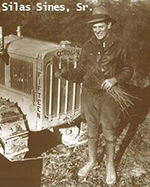 In 1914, Besley pioneered and championed the development of the state tree nursery at College Park. The establishment of the tree nursery significantly aided Besley's efforts to restore Maryland's forests. Besley, who served in this leadership position from 1906-1942, certainly had the time to make a huge contribution to restoring Maryland’s forest.
In 1914, Besley pioneered and championed the development of the state tree nursery at College Park. The establishment of the tree nursery significantly aided Besley's efforts to restore Maryland's forests. Besley, who served in this leadership position from 1906-1942, certainly had the time to make a huge contribution to restoring Maryland’s forest.
In 1927, Besley hired Silas Sines, a native of Garrett County. Silas served as superintendent of the College Park state tree nursery. Starting in the late 1920s until 1974, Sines oversaw and guided the growth and operations of the state nursery. Silas developed methods for economically growing and replanting large numbers of healthy trees throughout Maryland.
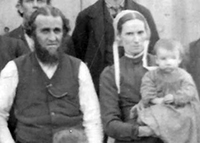
| In the early 1930s, as a tribute to his mother on Mother's Day, Silas presented his parent, Alice Sines, a Canadian eastern larch tree that he had started from seed at the tree nursery. Family members planted this tree in front of the Sines' home place located off Sines Cemetery Road near the entrance of Swallow Falls State Park. |
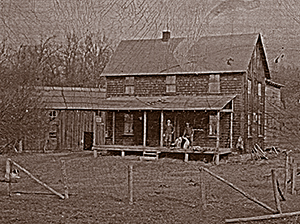
Sines Family Home
The site on which this tree is planted is significant to conservation, for it is from this locale at the Sines’ home that Fred W. Besley launched the nation’s first statewide forest inventory. Besley stayed as a guest at the Sine’s home during this time.
Each day, Silas's father, William “Taylor” Sines, transported Besley around Garrett County in a horse-drawn fringed surrey while the pioneering forester inventoried the forests of Garrett County. Proudly wearing a conservation badge issued by the state forester to make him official, Taylor Sines was perhaps Besley’s first state-hired field hand.
Upon returning to the Sines home after a long day of fieldwork, under the light of a kerosene lamp, Besley organized and studied his field notes. After “tramping every cow-path in Maryland,” Besley completed his inventory and wrote a book titled “The Forests of Maryland,” printed in 1916. This book is noteworthy as it is the first statewide forest inventory ever published in America.
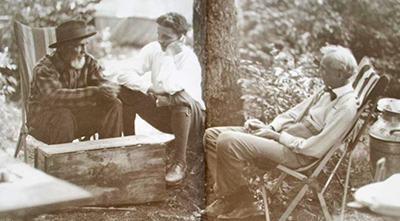
In the summer of 1921, three wealthy captains of industry – Henry Ford, Thomas Edison, and Harvey Firestone - who as a group called themselves “the vagabonds,” camped along Muddy Creek (present day Swallow Falls State Park). Taylor’s brother, Henry Sines, occasionally visited the Vagabonds at their camp and shared with them local information of interest to the famous tourists. Another of Taylor’s brothers, Abraham Lincoln “Link” Sines, served as a nature guide for these well-known industrialists during their stay in Garrett County.
In 1913, Besley hired Link Sines to serve as a Maryland Forest Warden, one of the first forest wardens that the State Forester hired. While Link performed his forest warden duties, he often took his nephew Silas with him and educated the younger man about the responsibilities of his position while performing his duties. Link, who would later be known as western Maryland’s first resident forest warden, lived at Herrington Manor where he oversaw “Swallow Falls State Forest.” |
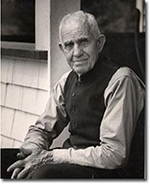
|

During the Vagabond’s visit to Garrett County visit, Henry Ford took an interest in purchasing an old sawmill steam boiler, an antiquated treasure once owned by the Sines family that the they originally operated near their home place. Link’s brother in law, Newton Reams, sold the boiler to Henry Ford. Reams transported this boiler to Oakland and shipped it by train to Dearborn, Michigan. Today, the Henry Ford Museum in Michigan houses the sawmill steam boiler.
The nationally publicized camping trips the Vagabonds took between 1915 and 1924 caused citizens to demand from their elected officials to set aside for outdoor recreation more land for forests and parks. The Vagabonds helped launch what is now a multi-billion dollar outdoor recreation industry.
The eastern larch tree that quietly grows at the former Sines family home place serves today as a living monument for all who enjoy America’s natural resources. This tree marks the spot where numerous lasting contributions were made by the Sines family – Maryland’s first family of forest conservation.
Photographs (top to bottom):
- Eastern larch tree at the fomer Sines family home place in Garrett County, photograph courtesy of Champ Zumbrun
- Silas Sines, Sr.
- William Taylor Sines and his wife Alice Sines
- Sines family home
- Henry Ford talking with young Henry Sines at Muddy Creek Campsite
- Abraham Lincoln “Link” Sines
- Sawmill steam boiler, once owned and operated by the Sines family
Acknowledgements:
Maryland State Forests and State Parks
Significant Monuments and Landmarks In Garrett County, Maryland
By Offutt Johnson and Champ Zumbrun
Edited by Nina Higgins
July 11, 2013
Sources:
- Committee for 150th Anniversary for the Town of Lonaconing, Maryland. Lonaconing: Home In the Hills. Lonaconing, 1987.pp. 31-33.
-
Friedenberg, Robert V. Chronology of Theodore Roosevelt's Speeches
- "Gus DeLawder Dead." Cumberland TImes News 11 September 1906
- Schlosnagle, Stephen. Garrett County: A History of Maryland's Tableland. 1978. pp. 289-290
- Silas Sines Jr. The Family of Silas Sines Sr. Francis Champ Zumbrun.
- "Twenty Years Ago." Cumberland Times and Sunday Times 29 December 193
- Zumbrun, Francis Champ.
Fred W. Besley: Forestry Pioneer. November 2005.
- Zumbrun, Francis Champ. Famous Travelers: Edison, Ford, Firestone. 2009.
Back to Feature Stories